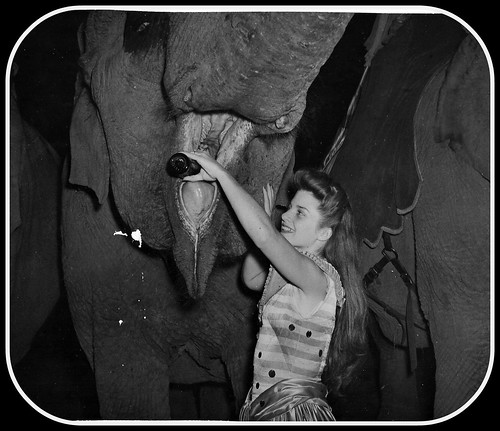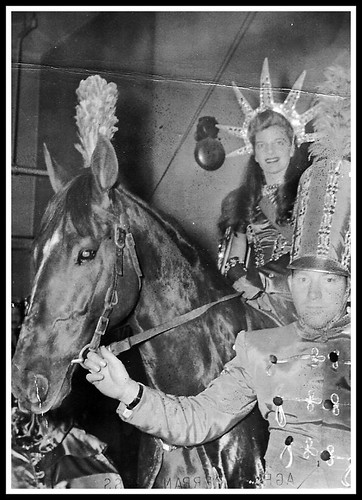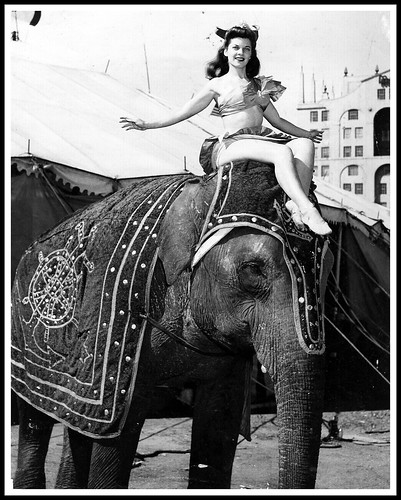 Oct. 14, 2010
Oct. 14, 2010
They were on an elephant stakeout, deep in the city's urban heart.
The three city animal control officers stood on a grassy berm early Wednesday, their eyes cast on the long gray circus train sitting quietly in a rail yard along Chouteau Avenue.
They were waiting for the elephants to begin their two-mile walk to the Scottrade Center. But that moment was hours away.
"This sure is different," said Ron Fischer, a 13-year animal control veteran accustomed to policing the city's cats and dogs, maybe a snake or bat, too, but never a pachyderm.
Still, these officers were intent on inspecting the elephants, which belong to Ringling Bros. and Barnum & Bailey Circus, in town for seven shows through the weekend.
It was not always like this. Circus animals typically draw attention only from state and federal authorities. But just last week, Fischer and the city's seven other officers got special training to spot problems with elephants, tigers and zebras.
The class was paid for by PETA, the animal rights group that is an avowed enemy of using animals for entertainment. The class — and its unusual alliance between activists with a clear agenda and public agencies — is a new effort to give local animal control agencies across the nation greater familiarity with circus animals. Last month, Sacramento, Calif., animal control officers who took a similar class forced the Ringling circus to limit the performances of an elephant, Minyak, because of arthritis.
St. Louis officials welcomed PETA's offer of help. This was the first time the program had been tried outside California.
In recent years, scrutiny of circuses and other animal acts has grown as groups like PETA and the Humane Society of the United States publicized cases of abuse and inadequate care. Circuses have responded with greater transparency about their animals' lives. They host open houses to showcase living conditions. They stress their commitment to animal welfare.
"We're inspected everywhere. We're proud of the animal care we give," said Steve Payne, a vice president with Virginia-based Feld Entertainment, owner of the Ringling circus.
Last year in St. Louis, animal control officers tried to inspect the circus. But the circus train arrived hours earlier than expected, and the officers missed seeing the elephants walk to the arena, a crucial time for assessing how the giant animals are walking.
Plus, the officers had no clue what to look for, said Drew Hane, supervisor of St. Louis Animal Control and Care.
"Show me a dog or a cat, and I'll talk about it all day long," Hane said. "Asian elephants? Not so familiar."
The five-hour training class was led by Cindy Machado with the Marin Humane Society in California. She showed undercover footage of circus elephants being mistreated. She displayed a bull hook, a controversial tire iron-like device sometimes used to control elephants.
Abel Lopez, a nine-year animal control veteran, was shocked. Before taking the class, he had told his two young daughters he planned to take them to the circus. "But now, I don't want to take them," Lopez said.
About 1 p.m. Wednesday, Hane walked up to his group of blue-shirted animal control officers.
"OK, you guys ready?" he asked.
Hane, Lopez and Fischer, plus other officers who had arrived later, headed down the gravel railbed toward the elephant cars. They were armed with tiny white notepads and cameras. Hane carried a letter from the city health department, which oversees animal control, authorizing the inspection and allowing three PETA-funded elephant experts, including a veterinarian, to assist as consultants.
"They are a little concerned about the other people we brought," Hane said of the circus.
The elephants slowly emerged from the railcar, their backs dusty with straw. Several young elephants moved onto a tractor-trailer to be driven to the arena.
The six other elephants moved in a neat line. Circus workers held up a yellow ropeline on either side. Trainers with bull hooks stood in front and back. The elephants strolled. But their expansive gait meant the people had to jog to keep pace.
Lopez trotted along beside the last elephant, the largest one. He peered again and again at the elephant's front right leg. He called over the veterinarian hired by PETA, asking him whether it looked as if the animal might be favoring her knee, a potential sign of arthritis. The veterinarian, Mel Richardson, agreed. But further examination was needed.
The elephants and handlers, the animal control officers and experts, moved in a herd toward the paved expanse of Chouteau. Once off the gravel, the elephants lined up shoulder to shoulder and flipped up their paws so handlers could remove any stuck bits of gravel.
Then the elephants stepped onto the road, with police stopping traffic and astonished onlookers pulling out cameras.
The elephants walked through downtown and into the bowels of the arena. It was there that circus officials stopped the PETA experts. The experts would not be allowed to be part of any inspection. City officials and the circus hammered out a compromise. A large-animal veterinarian from the St. Louis Zoo would consult with the animal control agency instead.
"The animal rights activists, biased with an anti-circus agenda, were very objectionable to us," Payne said.
City animal control plans a full-scale inspection today to look for signs of animal cruelty or inadequate housing, Hane said. Any findings will be released immediately. And leaving nothing to chance, two animal control officers will be posted near the animals' quarters for 15 hours a day, until the circus trains depart.
____________________________________________________________________
Well it look's like crazy has just slipped into the world of insane. Peta giving "clinics" to animal control officers about animal cruelty. I we had been thinking we would have had Saddam Hussein give clinics on democracy, before we fitted him for a Texas Necktie. He would have done as good of a job as Peta, given he knew as much about democracy as they do about animal welfare. I trust the counterfeit St. Louis Animal Control Dept. is as vigilant when the local Budweiser hitch come's to town, as well as the many livestock shows. But maybe it is easier to keep an eye on on car full of elephants, instead of 50 or 60 stock trailers being unloaded. I must have died some time ago, and just awoke, because it seem's like elephants are the only animal alive anymore. What a "get in line, and follow the lemming in front" mentality these sad sacks have developed. If Ingrid Newkirk really wanted to help, she would activate her last will and testament immediately, by offing herself in clean way so as not to damage any leather, and have a couple of note pads made, one from her left haunch and one from her right, as "field journals" for the twit giving these clinics, and the Mayor who permit's them. As USDA has brought up the very valid issue of "qualifications," I suggest we lobby for the same standard, for peta animal welfare experts.
 Trained by Alex Kerr for this appearance with Bertram Mills' circus, Olympia, London 1950-1951
Trained by Alex Kerr for this appearance with Bertram Mills' circus, Olympia, London 1950-1951






























